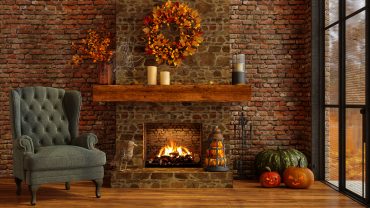Unlike other design styles that strive for perfection and polish, modern industrial interior design embraces imperfections and makes them a focal point. It’s a visceral, rugged style with a laid-back personality that tells a story through its components that would usually be hidden.
The industrial interior style has been described as the ‘grunge baby of modern and farmhouse aesthetics’ and the ‘personification of authenticity’ and it draws inspiration from industrial spaces such as factories, warehouses, mills, ironworks and the like.
The core characteristic appeal of industrial interior design lies in its focus on unrefined materials. Exposed brick walls, visible ductwork, and metal fixtures are hallmarks of industrial interior design. Lighting is typically factory-like in feel, so think metal pendant lights or oversized Edison bulbs, and the furniture is often a mix of old and new, with vintage and modern pieces coexisting. Sustainability is a key factor, using reclaimed wood or metal fittings. The overall effect is a space that feels both lived-in and aesthetically striking, offering a unique blend of history, functionality, and style.
So, whether you’re renovating a house or looking to bring a touch of modern industrial interior design to a city loft space, understanding the essence of industrial interior style is the key to creating an exciting, edgy and timeless space.
The History of Industrial Interior Design

Industrial interior design style apartment (Credit: alvarez. via Getty Images)
What is industrial interior design? It’s a style that draws inspiration from the warehouses and factories of the Industrial Revolution, where function-oriented design reigned supreme.
It evolved from the need to repurpose old industrial spaces in the 1960s and 1970s into livable areas, thus maintaining the original elements that defined these spaces – exposed pipes, concrete floors, and large grid-paned windows. While it distinctly celebrates the industrial era’s architecture and design elements, it often incorporates modern touches and can blend seamlessly with other interior styles, such as modern or minimalist, creating a unique and customised feel.
Today, the previously dilapidated and unusable former industrial spaces in areas around Old Street, Shoreditch and Hoxton in London, and indeed in most major cities around the world, have seen massive redevelopment, an influx of new, exciting and disruptive businesses and highly sought-after residential property.
What is Industrial Interior Design?

An office utilising an Industrial interior design. (Credit: Westend61 via Getty Images)
The principles of industrial house design revolve around maintaining an open layout and embracing an aesthetic that feels both organic and a bit rough around the edges, yet with an element of urban sophistication. Key elements include high ceilings, open spaces, and minimalistic, yet functional furniture.
Functional Simplicity
Industrial design emphasises the use of items that are functional and necessary, avoiding excess. Furniture and decor are chosen for their utility and are often straightforward and uncomplicated in design. Vintage and salvaged items are popular as well as decor such as industrial signage, funky or edgy artwork and even neon!
Open Plan Space
Similar to minimalism, industrial design values open, uncluttered spaces. This is often seen in the layout of industrial-styled rooms, which tend to have fewer walls and barriers, creating a sense of openness and space, reminiscent of the spaces they once were. It also creates a sense of serene clarity and adds a visual flow.
Neutral Colour Palette
Industrial interior style is generally focussed on neutral and monochromatic colour schemes, which create a calm, cohesive look. Industrial design often incorporates greys, blacks, and whites, similar to minimalist interiors. Of course there’s always room for a splash of bold colour to add vibrancy and a visual aspect to the room.
Raw and Unfinished Aesthetics
Industrial interior design finds beauty in raw and unfinished elements like exposed brick, ductwork, and concrete. However, these are used in a restrained way that aligns with minimalist principles of avoiding excess.
Where modern industrial interior design is concerned, it’s the architectural elements hidden in other styles that become the focal point. The style embraces exposed structural elements such as brickwork, wooden or steel beams and rafters, visible piping and ductwork, concrete floors and reclaimed, repurposed and weathered wood. Metallic elements including steel, aluminium, copper, pewter and brass, utilitarian furniture and open-plan living add visual cues to the space.
Where Yesterday Meets Today: Industrial Interior Design

A kitchen designed with black industrial design. (Credit: NelleG via Getty Images)
Industrial interior design is a celebration of the functional and the historical, blending the raw beauty of industrial elements with a minimalist approach to create spaces that are both practical and aesthetically compelling.
It’s a style that pays homage to the architectural legacy of the industrial era, while adapting to modern needs and sensibilities. Through its use of neutral colours, emphasis on open spaces, and incorporation of reclaimed materials, industrial house design creates environments that are not only visually striking but also rich in history and character.












